
* The F-15 has flown with the US Air Force, as well as the air forces of Israel, Saudi Arabia, Japan, and South Korea; it is also now being obtained by Singapore and Qatar. This chapter provides a service history of the F-15 with its various users.
* The USAF built up F-15 squadrons through the 1980s, deploying them to Europe and across the Pacific, and supplying them to air-defense squadrons in the continental US. The continental air-defense role was generally seen as a secondary function, and by 1990 the Eagle had been phased out in this role in favor of the more economical F-16 Air Defense Fighter (ADF) variant.
The Eagle didn't see combat under American colors until the Gulf War in 1990. Following Saddam Hussein's invasion of Kuwait, 48 Eagles were dispatched from Langley AFB in Virginia to Saudi Arabia immediately, arriving at Dharan after up to 17 hours in flight and up to eight inflight refuelings. More F-15s arrived over the following months, and by the time of the beginning of the air war against Iraq on 17 January 1991, there were five F-15C air-combat squadrons, with a total of 96 machines, and two F-15E Strike Eagle squadrons, with a total of 48 shiny new aircraft, operating in the conflict from airbases in Saudi Arabia and Turkey.
USAF F-15C/Ds flew some 2,200 sorties for a total of 7,700 hours in flight, scoring 33 kills for no air combat losses of their own, though one was lost in an accident. BVR combat had come of age, with Eagle crews scoring kills on enemies they never set eyes on. None of the kills were performed with the cannon, most being performed with the AIM-7 Sparrow -- though the fact that the Iraqi air force was reluctant to come to grips with Coalition air power was partly responsible for the lack of close-in combat. Eagle availability and turnaround time were reported as outstanding.
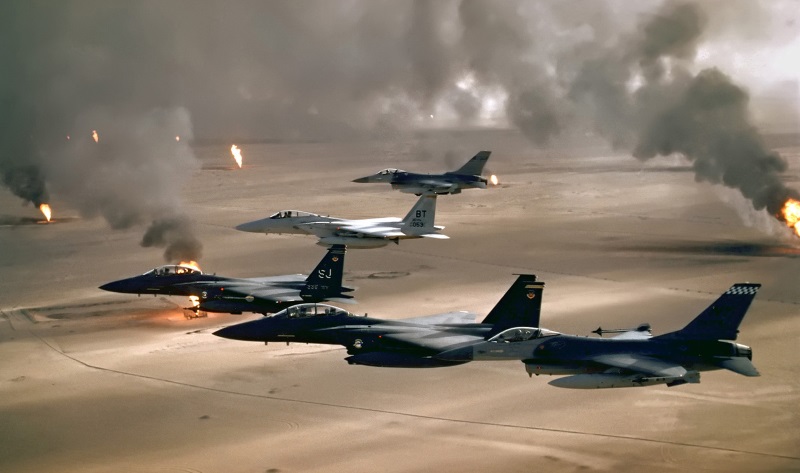
Strike Eagles kept busy during the war, pounding bridges and aircraft shelters; "plinking" tanks; and hunting for Iraqi Scud tactical missiles, though with little success in that role. Most strikes were performed using radar as the primary sensor, since the LANTIRN pods were only coming into service, and were available only in limited numbers and at the end of the conflict. The LANTIRN pods also proved to have some teething problems, not all that surprising for a new and complicated weapons system.
Also unsurprisingly, two Strike Eagles were shot down by ground fire. One Strike Eagle actually scored a kill on an Iraqi Mil Mi-25 helicopter gunship with a laser-guided bomb on 14 February 1991: the helicopter had been targeted while on the ground but took off after the launch of the LGB. The WSO, undeterred, kept the helicopter in the crosshairs of his LANTIRN pod until the bomb went home. This was the first air-to-air kill of the Strike Eagle.
* After the Gulf War, the USAF began to cut down and restructure their F-15A/B/C/D force in light of changed requirements with the end of the Cold War and force reductions. The fleet fell from 342 to 252 by 1997, with many F-15A/Bs sent to the desert "boneyard" at Davis-Monthan AFB in Arizona and cannibalized for spares. The USAF continued to build up the Strike Eagle force.
Despite the end of the Gulf War, America was by no means done with Saddam Hussein, though figuring out what to do about him would take time. The US set up "no-fly zones" in northern and southern Iraq where no Iraqi aircraft could fly. The northern zone was set up to help protect the local Kurds from attacks, while the southern zone was set up to provide a buffer between Iraq on the north and Kuwait and Saudi Arabia on the south.
USAF F-15Cs patrolled these areas, though things did not always go smoothly. On 14 April 1994, two Eagles on patrol in the northern no-fly zone shot down two helicopters that had been identified as Iraqi Mil Mi-24 Hind gunships. They turned out to be US Army UH-60 Black Hawk transport helicopters; all 26 on board the helicopters were killed. Although this was an extraordinary cockup, in general the whole situation was unsatisfactory and was getting worse. Saddam Hussein resisted all attempts to keep him under control or "contained", and squabbles between US and British aircraft and Iraqi air-defense sites became more and more common. Strike Eagles were prominent participants in the retaliatory strikes that inevitably followed such confrontations. It was like pounding sand down a rathole; the strikes did nothing to resolve the troublesome situation.
* In the meantime, the US was reluctantly becoming involved in the messy series of conflicts in the Balkans that followed the disintegration of Yugoslavia. In 1993, USAF Eagles began what would become a series of deployments to Aviano AB in Italy, which became the forward operating field for sorties over the Balkans. As with Iraq, the situation steadily escalated.
Strike Eagles conducted attacks against Serbian targets with LGBs and EOGBs in 1994 and 1995. In the spring of 1999, events reached a climax with the NATO air campaign against what was left of Yugoslavia, provoked by unrest in neighboring Kosovo. Strike Eagles were heavily involved with attacks against Yugoslav forces, and F-15Cs scored four kills against MiG-29s. Captain Mike Shower and Lieutenant Colonel Cesar Rodriguez (who already had two kills against Iraqi aircraft to his name) each shot down a MiG-29 using the AMRAAM on 24 March 1999; and Captain Jeff Hwang shot down two more MiG-29s in a single engagement on 26 March, also using AMRAAM.
BACK_TO_TOP* After that, events in the Balkans went relatively quiet, but that didn't mean peace was breaking out all over; far from it. On 11 September 2001, Islamic terrorists hijacked airliners and flew them into the World Trade Towers in New York and a wing of the Pentagon, killing about 3,000 people. The all but unanimous reaction of American citizens was of shock and rage. F-15s, along with F-16s, performed combat air patrols under Operation NOBLE EAGLE to protect American cities from similar attacks. The attacks were not repeated -- which was highly fortunate, since such a situation would have very likely forced USAF pilots to shoot down airliners loaded with innocent civilians.
More proactive actions were under consideration. The central hub of Islamic terrorist activities was Afghanistan, then under rule of the Taliban, an Islamic religious extremist group that provided safe haven to Saudi master terrorist Osama bin Laden. Osama had built up an extensive set of camps in Afghanistan that provided sophisticated training in terror tactics for Islamic extremists from around the world, as well a center where operations such as the "9-11" attacks, as they came to be known, could be planned. The terrorist infrastructure in Afghanistan, and by implication the loose organization it represented, became known as "al-Qaeda", Arabic for "the Base".
The US government demanded that the Afghan government hand over Osama; the Taliban leadership predictably refused. In late October 2001, the US military began an air campaign against Afghanistan in preparation for ground actions, with Strike Eagles playing a significant role in the attacks. The entire campaign was patriotically named Operation ENDURING FREEDOM.
The initial waves of strikes against infrastructure seemed like overkill, since after years of civil war and internal decay Afghanistan didn't have much infrastructure left to bomb, but it was a case of ensuring that the follow-on air effort, of precision attacks against Taliban concentrations, could be conducted with impunity. US Central Intelligence Agency (CIA) agents paved the way for ground operations with assistance to anti-Taliban elements, as well as generous bribes to Taliban supporters to encourage them to change sides. With local forces braced by US and British special operations teams, the Taliban was put to flight.
Strike Eagles were able to hit them day and night. F-15Es also hit al-Qaeda cave hideouts with AGM-130 standoff missiles and other precision weapons. Mudhen crews became very skilled at using LGBs to nail vehicles moving down roads at high speed. A new "thermobaric" bomb that generated a concussive fireball that could penetrate deep into tunnel strongpoints was introduced late in the campaign.
* After invading Afghanistan, the US turned its sights on Saddam Hussein. Late in 2002 the Bush II Administration began to accuse the Iraqis of concealing a "weapons of mass destruction (WMD)" program, threatening invasion if such weapons were not immediately destroyed. The American agitation against Iraq led to sharp international controversy, with France leading a group of countries who were unpersuaded that Iraq was a threat, and unconvinced by US claims about Saddam Hussein's weapons programs and links to al-Qaeda, with later events proving the French correct on that score.
In fact, it is likely that such claims were, if not necessarily mere pretexts, at least much less important than simple exasperation with more than a decade's efforts to "contain" Saddam Hussein. In any case, in the spring of 2003 the US invaded Iraq under Operation IRAQI FREEDOM. Strike Eagles were once more prominent participants, with the JDAM weapon being a preferred weapon. Once again, the Americans swept all resistance before them. However, as it turned out, sweeping resistance to the side didn't mean it went away, and US soldiers soon found themselves grappling with a stubborn counterinsurgency war, up until the withdrawal of US forces in 2010.
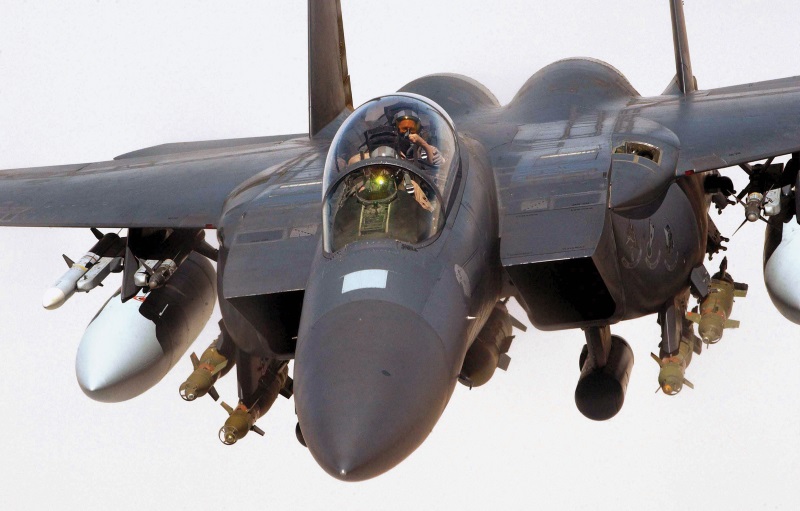
Strike Eagles have since participated from 2014 in the campaign against Islamic State insurgents on a rampage through the cojoined regions of Iraq and Syria. In 2017, Strike Eagles shot down two Iranian-made Shahed 129 drones -- along the lines of the US Predator drone -- operated by the Syrian government, with one kill on 8 June and the other on 20 June. These were the second and third air-to-air kills performed by the Strike Eagle.
There are rumors Strike Eagles have conducted strikes on Islamist forces in Africa, presumably in support of French ground forces, but the Air Force neither confirms nor denies such reports. Also from 2014, following the Russian seizure of Crimea, F-15Cs have participated in air patrols in support of the Baltic States, who were being intimidated by the Russians. Strike Eagles also continued to fight in Afghanistan; confronted with a resurgent Taliban, the US lost enthusiasm for the war there -- withdrawing in 2021, with the Afghan government collapsing with shocking speed.
* Although the USAF obtained the Lockheed Martin F-22 Raptor as the service's first-line air-superiority fighter, the F-22 was expensive and production was cut well short of planned acquisitions. As a result, the F-15 remains an important asset in the air combat role; similarly, delays in the introduction of the Lockheed Martin F-35 strike fighter means the Strike Eagle continues to be a valuable weapon system. The F-15 is showing no signs of going away for the time being.
BACK_TO_TOP* Six foreign nations have, so far, obtained the F-15: Israel, Japan, Qatar, Saudi Arabia, South Korea, and Singapore. There were announcements of sales to Egypt and Indonesia in 2022, but few specifics were released. The F-15 was evaluated by a range of other nations, including West Germany, Britain, France, Canada, Australia, and Iran, but though Iran in particular was enthusiastic about the type, none of these nations ever obtained the Eagle.
The Israelis have received Eagles under the "Peace Fox" series of programs. They are the only foreign operators of the F-15A/B variants. All Israeli F-15A/B aircraft were hand-me-downs:
The Israelis called the F-15A/B the "Baz", Hebrew for "Falcon". Following acquisition of the F-15A/Bs, the Israelis received 18 F-15Cs and 13 F-15Ds, all new-build aircraft. The last five F-15Ds, which were shipped in a later batch, were apparently Strike Eagle airframes finished to an F-15D-type configuration, since the F-15D was no longer in production when they were built. Israeli F-15Cs were given the name "Akef", Hebrew for "Buzzard". Israeli Eagles were given Israeli-designed countermeasures gear and fitted with Israeli-built munitions, such as the Rafael Python heatseeking AAM.
In November 1993, the Israeli government decided to acquire 25 new-built "F-15I" derivatives of the F-15E for the long-range strike role, with the official order placed on 12 May 1994. Initial flight of the first F-15I was on 12 September 1997, leading to initial deliveries in January 1998. All 25 machines were delivered by the end of 1999. The Israeli Air Force named the F-15I the "Ra'am", Hebrew for "Thunder". The variant was essentially a late-production F-15E with F100-PW-229 engines. It featured:
The Israelis obtained the LANTIRN targeting pod system. The F-15Is were painted in a three-tone camouflage scheme, with gray underneath and banded sand, blue, and brown on top.
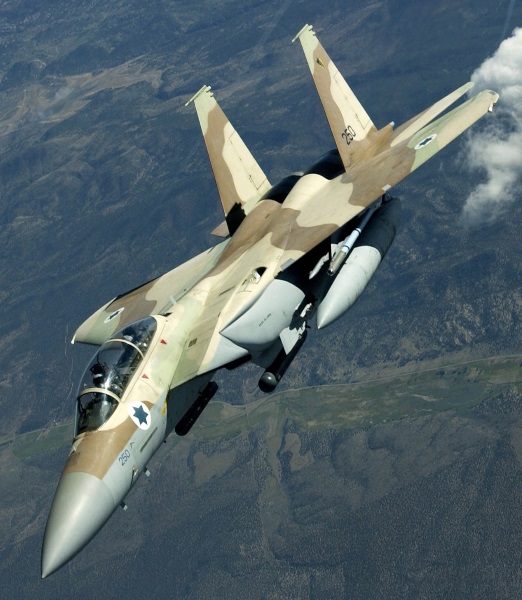
* The Israelis had not provided much in the way of upgrades for their F-15A/B/C/D machines up to the arrival of the F-15I, though some sources claim that the F-15A/Bs were modified to carry Dash-1 CFTs, making them the only operational F-15A/Bs to do so. There was a plan to perform an MSIP-class upgrade, but it was canceled. Apparently the upgrade plan was axed late in the game, since many sources claim that it was actually performed.
In any case, following the arrival of the F-15I, the Israelis began an improvement effort for their older F-15s under the "Baz Meshupar (Improved Eagle)" program. This featured elements of the F-15I, such as the modernized cockpit, GPS-INS navigation system, and DASH helmet. The first rebuilt Baz Meshupar was rolled out in November 1998, with the program completed in 2005. The Israelis also acquired ten hand-me-down USAF F-15Ds in 2016, presumably as attrition replacements, and no doubt they have been updated as well.
Further upgrades of the Israeli Eagle fleet have been performed, mostly to install improved avionics. When a new processor was deemed necessary for the F-15I, instead of replacing the old one and trying to duplicate its capabilities, the old one was left in place to perform its existing tasks, and a modernized processor was added to perform new tasks. A full "Baz 2025" upgrade program has been conducted, amounting to a service-life extension program (SLEP) in which the airframe and electrical systems were brought up to generally new condition, the idea being to keep the Baz fleet current to 2025.
An extensive upgrade program for the F-15I Ra'am fleet is now in the works, the centerpiece being the Raytheon AN/APG-82(V)1 AESA radar system, as used in the upgrade for USAF Strike Eagles. Status of this effort is not clear. The Israelis are also considering buying Advanced F-15s.
* The Israelis were the first to put their Eagles into combat, claiming five kills against Syrian MiG-21s on 27 June 1979 in what sounds like a completely unequal contest. Israeli Eagles then flew "top cover" for F-16 Vipers during the raid on the Iraqi Osirak nuclear reactor on 7 June 1981, and racked up dozens of kills during the Israeli Air Force's "turkey shoot" against the Syrians over Lebanon's Bekaa Valley in 1982. Eight Israeli F-15s also performed a daring strike on the Palestinian Liberation Organization's headquarters in Tunis on 1 October 1985. The F-15I is currently Israel's primary long-range strike and reconnaissance asset, being extensively used in the never-ending clashes in the region.
BACK_TO_TOP* Saudi Arabia has received a good number of F-15s under the "Peace Sun" series of export programs. The first deliveries provided 46 F-15Cs and 16 F-15Ds, for a total of 62 aircraft; the US Congress had specified that the Saudis should have no more than 60 Eagles, but two were lost in accidents, and replacements were provided. A further batch of 12 attrition aircraft was ordered in 1991, consisting of nine F-15Cs and three F-15Ds.
The limits went out the window during the Gulf War, and 24 F-15C/Ds were transferred from the USAF in Europe to build up Saudi warfighting strength. Some sensitive countermeasures gear was removed from these aircraft before delivery.
Saudi F-15s have scored a number of kills. Two Royal Saudi Air Force (RSAF) F-15Cs shot down two Iranian F-4Es during a border confrontation on 5 June 1984. This is one of the few times, possibly the only time, one McDonnell Douglas fighter shot down another. Two kills were scored by a Saudi F-15C pilot, Captain Ayehid Salah al-Shamarni, against Iraqi Mirage F1 fighters during the Gulf War.
* In 1991, after the Gulf War, the Saudis began shopping for new weapons, and MDD tried to sell them a single-seat version of the Strike Eagle designated the "F-15F", which Congress shot down; then a two-seat detuned version of the Strike Eagle designated the "F-15H", which Congress also shot down; and then another proposal along the same lines, originally designated the "F-15XP". This one did fly, Congress giving the go-ahead on 10 May 1993, with the type becoming the "F-15S".
The Saudis received 72 F-15S Strike Eagles from 1995 into 2000. Some sources claim that some of these machines were intended for the air-superiority role, but other sources contradict this, pointing out that the Saudis have plenty of older F-15s for that task.
The F-15S featured a slightly simplified "AN/APG-70S" radar that deleted terrain-mapping mode; the F-15S also had a downgraded self-defense suite. The Saudis did obtain 48 sets of a simplified version of the LANTIRN pod system, featuring the AN/AAQ-19 Sharpshooter targeting pod and the AN/AAQ-20 Pathfinder navigation pod. Some sources claim these aircraft were initially delivered with Dash-1-style CFTs, meaning that offensive stores had to be carried on the centerline and wing pylons, usually with multiple-ejector racks -- but the Saudis later received the full Dash-4 CFTs with their stores attachments. There was some fuss in the Congress over the sale of the F-15S to Saudi Arabia, which helped lead to the later sale of the F-15I to Israel as a counterbalance.
In 2009, the Saudis ordered Lockheed Martin Sniper Advanced Targeting Pods to replace the LANTIRN targeting pods used on the F-15S. In 2011, the Saudis placed an order for 84 "F-15SA" fighters, as well as upgrades for 68 surviving Saudi F-15S machines; the older F-15S machines are being upgraded under the "F-15SR" effort. The upgrade will be implemented locally by the Alsalam firm -- except for the first two upgrades, performed in the USA -- with each upgraded machine receiving a new forward fuselage and new wings.
In any case, these aircraft are in an Advanced F-15 configuration, with:
The F-15SAs have been qualified for the latest munitions. They also had extra stores pylon outboard on the wing, for a total of five pylons. The F-15 was actually designed with five pylons at the outset, but the outboard pylons didn't mesh well with the original flight-control system; the F-15SA's new digital FBW flight-control system didn't have a problem with them. With the outboard pylons and the stores attachments on the bottom of the CFTs, the F-15SA could carry a heavy munitions load, for example:
-- for a total of eight AMRAAMs and eight Sidewinders. In a long-range strike configuration, it could carry:
-- for a total of six AMRAAMs, two Sidewinders, and 20 SDBs.
Three development aircraft were flown for the program, the first taking to the air in early 2013; these appear to have been new-build machines. Initial deliveries of service aircraft to Saudi Arabia were in December 2016. It is not clear when the last will be delivered, and when upgrades will be complete.
In 2017, the Persian Gulf state of Qatar ordered a set of 36 "F-15QA" Eagles, of similar configuration to the Saudi Eagles -- but with larger cockpit displays, a new low-profile HUD, and the AN/APG-82(V)1 AESA radar. They will also have a more capacious nose to handle more systems, and an updated wing structure. Deliveries were in 2021:2023.
BACK_TO_TOP* The Japanese Air Self-Defense Force (JASDF) is the biggest foreign user of the F-15, and Japan is the only license-builder of the type. Japan was interested in the Eagle early on, with JASDF pilots evaluating the F-15A/B at Edwards Air Force Base in 1975.
Japan's location off the Asian mainland puts the country close to potentially hostile nations that could perform fast intrusions into Japanese airspace with little warning, and the F-15's outstanding climb rate and high speed meant it would be able to react very quickly to intercept intruders. The evaluation led to a decision to adopt the Eagle as Japan's first-line air-defense fighter, with a contract awarded to Mitsubishi in 1978 for license construction of the "F-15J/DJ" Eagle.
The F-15J/DJ was effectively an early production F-15C/D with some Japanese technology. The AN/ALQ-135 jammer was replaced by a Japanese J/ALQ-8 jammer; the AN/ALR-56 RWR was replaced by a J/APR-4 jammer; and the aircraft was fitted with a datalink, to connect it to the Japanese ground-controlled intercept network.
The JASDF acquired 203 single-seat F-15Js and 20 tandem-seat F-15DJs. The first two F-15Js were delivered from MDD, the first flying at Saint Louis on 4 June 1980. All the other F-15Js were built by Mitsubishi. The first 12 F-15DJs were built by MDD, with the remaining eight assembled by Mitsubishi from knockdown kits provided by MDD. Most of the content of the Mitsubishi-built F-15Js was produced in Japan, with the engines manufactured by Ishikawajima-Harima Heavy Industries under license from Pratt & Whitney, the Japanese engines being designated "F100-IHI-100".
It is not believed that JASDF Eagles have ever fired a shot in anger, though the Japanese tend to be discreet about military confrontations. They have, however, performed many intercepts of Soviet-Russian, North Korean, and Chinese aircraft.
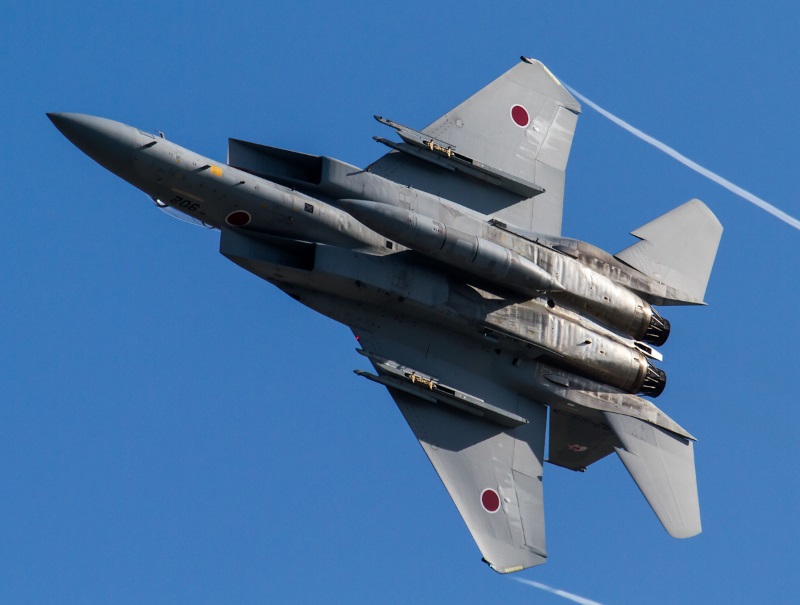
In recent years, the F-15Js have been equipped with the Japanese-built AAM-3 missile, an improved Sidewinder follow-on with distinctive "barbed" forward fins. Japan has been trying to obtain an advanced fighter to replace the F-15, but the search has been troublesome, and so the F-15J fleet is now being generally upgraded to keep the aircraft in fighting trim into the 2040s. Upgrades are being implemented in phases, but ultimately the refits will include:
The new radar will support the Japanese-made AAM-4 missile, the Japanese answer to the AMRAAM, and the helmet-mounted sight will support the AAM-5 dogfighting missile, which will replace the AAM-3. There's also talk of developing a new countermeasures system, though that has proven troublesome; and also of installing outer wing pylons for a total of four, with dual carriage racks permitting a load of up to 12 AAMs. Heavy AAM loads are seen as significant for defense against long-range cruise missiles and Chinese air incursions.
The Japanese are now working on a follow-on upgrade effort, the F-15 "Japan Super Interceptor (JSI)", with a next-generation radar, an upgraded countermeasures system, more warload, and long-range munitions. 68 Eagles will be updated, the rest of the fleet being retired and replaced by the F-35.
BACK_TO_TOP* The Republic of Korea (ROK / South Korea) was a relative latecomer in adopting the Eagle. In early 2002, the country decided to obtain the "F-15K" derivative of the F-15E from Boeing to fulfill the country's requirement for an "F-X" heavy fighter, which was devised partially as a response to the Chinese acquisition of advanced Sukhoi Su-30 fighters. The F-15K won the award in a final round of elimination with the Dassault Rafale, the Eurofighter Typhoon and Sukhoi Su-35 having been eliminated in the first round of the competition. The French team promoting the Rafale claimed that the award to the US aircraft was "politically motivated" -- an accusation indignantly denied by Boeing officials.
40 F-15Ks were procured for the ROK Air Force (ROKAF), along with spares and weapons, as part of a $4.6 billion USD deal. Initial flight of the F-15K was on 3 March 2005, with delivery of four machines to South Korea in that year, and first formal flight with the ROKAF on 12 December 2005. The type was introduced to service in early 2007, with 21 more aircraft ordered in 2008, and all 61 delivered by the spring of 2012. Korean Aerospace Industries (KAI) built wings and forward fuselages for all but the first eight machines.
ROKAF F-15Ks were the first production machines to be powered by General Electric engines. They were fitted with General Electric F110-GE-129 afterburning bypass jets; 88 engines were bought as part of the deal, with the first ten built by GE in the US and the rest assembled in Korea by Samsung. Apparently this decision was driven by a desire to de-standardize engines used by the ROKAF. South Korean F-16s used P&W F100 engines, and the ROKAF wanted to make sure the service wasn't at the mercy of a single supplier.
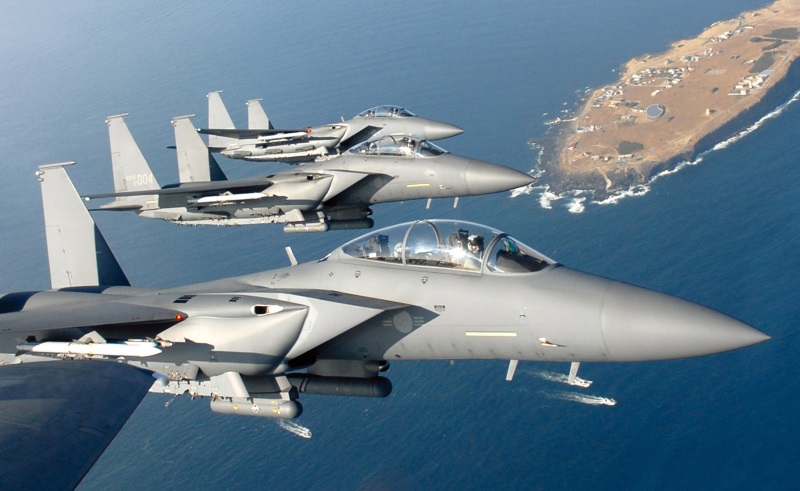
The F-15Ks were fitted with leading-edge technology, including:
The cockpit was NVG-compatible, and Korean pilots used the US JHMCS helmet-mounted sight system to target smart weapons. The F-15K carried a modernized LANTIRN pod system known as "Tiger Eyes", as well as stores such as the AMRAAM, AIM-9X, JDAM, JSOW, and other US munitions. The South Koreans have adopted the US AGM-84H SLAM-ER and German Taurus Systems KEPD 350 for carriage by their F-15Ks, the SLAM-ER leading to the F-15K's nickname, the "Slam Eagle".
An upgrade program is being defined for the F-15K fleet, which will include at minimum an AESA radar, new countermeasures systems, and new mission computer. The upgrades will be conducted from 2024 to 2034.
* In late 2005, Singapore signed a contract for 12 "F-15SG" (originally "F-15T") derivatives of the Strike Eagle, choosing the US fighter over the Dassault Rafale and the Eurofighter Typhoon. 12 more were ordered in late 2007. Although some details of the F-15SG were classified, they were fitted with AN/APG-63(V)3 AESA radar plus the Link-16 datalink, and powered by General Electric F110-GE-129 engines, the same as those fitted to the F-15K.
The F-15SGs also were the first Strike Eagles to feature the BAE Systems DEWS/CMS countermeasures system. The F-15SGs were equipped with AIM-120C AMRAAM and AIM-9X missiles, plus JDAM, JSOW, and JASSM munitions. Initial F-15SG deliveries were in 2008, with final deliveries in 2009 -- or so it appeared. Examination of records shows that additional machines have been quietly obtained, a total of 40 aircraft having been verified.
BACK_TO_TOP* The following list provides a production summary for the F-15:
There are discrepancies of counts between sources, but the quantities in this table can be regarded as reasonable estimates since the discrepancies are only by a value of one or two.
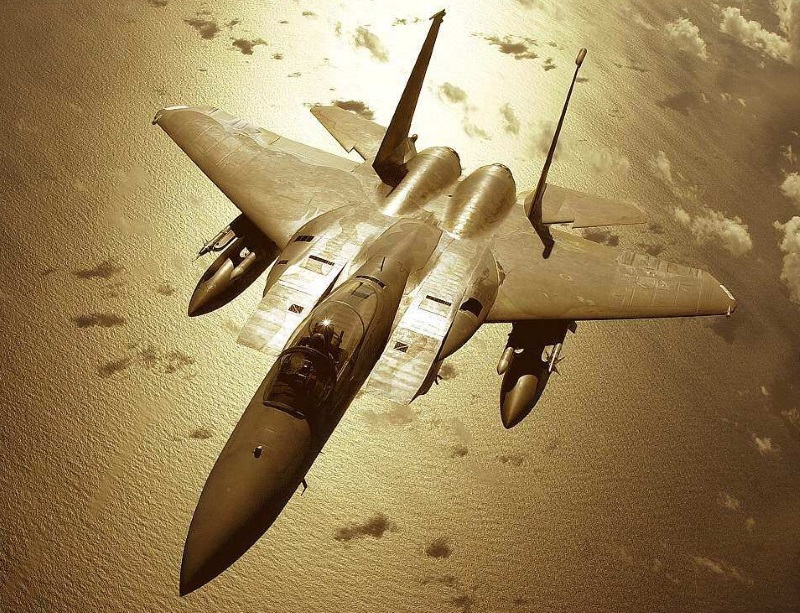
* Sources include:
* Illustrations details:
* Revision history:
v1.0.0 / 01 jul 03 v1.0.1 / 01 jul 05 / Review & polish. v1.0.2 / 01 jun 07 / Review & polish. v1.0.3 / 01 may 09 / Review & polish. v1.0.4 / 01 may 10 / Review & polish. v1.0.5 / 01 may 12 / New Saudi order. v1.1.0 / 01 apr 14 / General update. v1.1.1 / 01 mar 16 / Review & polish. v1.2.0 / 01 feb 18 / Review & polish, some rewrite. v1.2.1 / 01 dec 19 / Review, update, & polish. v1.3.0 / 01 nov 21 / Review, update, & polish. v1.3.1 / 01 nov 23 / Review, update, & polish. (*)BACK_TO_TOP
